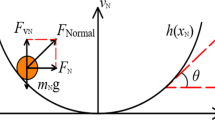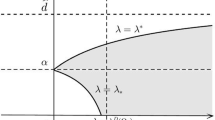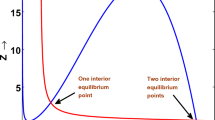Abstract
By introducing impulsive biological control strategy, the dynamic behaviors of the two-prey one-predator model with defensive ability and Holling type-II functional response are investigated. By using Floquet’s Theorem and the small amplitude perturbation method, we prove that there exists an asymptotically stable pest-eradication periodic solution when the impulsive period is less than some critical minimum value, and permanence conditions (that is, the impulsive period is greater than some critical maximum value) are established via the method of comparison involving multiple Liapunov functions. It is shown that our impulsive control strategy is more effective than the classical one. Furthermore, the effect of impulsive perturbations on the unforced continuous system is studied. From simulations, we find that the system has more complex dynamic behaviors and is dominated by periodic, quasi-periodic, and chaotic solutions.
Similar content being viewed by others
References
Andrews, J.F.: A mathematical model for the continuous culture of microorganisms utilizing inhibitory substrates. Biotechnol. Bioeng. 10, 707–723 (1968)
Bainov, D.D., Simeonov, P.S.: Impulsive Differential Equations: Periodic Solutions and Applications. Pitman Monographs and Surveys in Pure and Applied Mathematics (1993)
Bainov, D.D., Simeonov, P.S.: Impulsive Differential Equations: Asymptotic Properties of the Solutions. World Scientific, Singapore (1995)
Ballinger, G., Liu, X.: Permanence of population growth models with impulsive effects. Math. Comput. Model. 26, 59–72 (1997)
Caltagirone, L.E., Doutt, R.L.: The history of the vedalia beetle importation to California and its impact on the development of biological control. Ann. Rev. Entomol. 34, 1–16 (1989)
Croft, B.A.: Arthropod Biological Control Agents and Pesticides. Wiley, New York (1990)
DeBach, P.: Biological Control of Insect Pests and Weeds. Rheinhold, New York (1964)
DeBach, P., Rosen, D.: Biological Control by Natural Enemies, 2nd edn. Cambridge University Press, Cambridge (1991)
Donofrio, A.: Stability properties of pulse vaccination strategy in SEIR epidemic model. Math. Biosci. 179, 57–72 (2002)
Freedman, H.J.: Graphical stability, enrichment, and pest control by a natural enemy. Math. Biosci. 31, 207–225 (1976)
Hassell, M.P.: The Dynamics of Competition and Predation. p. 68. Arnod, London (1976)
Holling, C.S.: The functional response of predator to prey density and its role in mimicry and population regulation. Mem. Entomol. Soc. Can. 45, 1–60 (1965)
Lakmeche, A., Arino, O.: Bifurcation of non trivial periodic solutions of impulsive differential equations arising chemotherapeutic treatment. Dyn. Contin. Discret. Impuls. Syst. 7, 165–187 (2000)
Lakshmikantham, V., Bainov, D.D., Simeonov, P.S.: Theory of Impulsive Differential Equations. World Scientific, Singapore (1989)
Liu, X.N., Chen, L.S.: Complex dynamics of Holling type II Lotka–Volterra predator–prey system with impulsive perturbations on the predator. Chaos Solitions Fractals 16, 311–320 (2003)
Panetta, J.C.: A mathematical model of periodically pulsed chemotherapy: tumor recurrence and metastasis in a competitive environment. Bull. Math. Biol. 58, 425–447 (1996)
Pei, Y.Z., Chen, L.S., Zhang, Q.R., Li, C.G.: Extinction and permanence of one-prey multi-predators of holling type II function response system with impulsive biological control. J. Theor. Biol. 235, 495–503 (2005)
Pei, Y.Z., Li, C.G., Chen, L.S., Wang, C.H.: Complex dynamics of one-prey multi-predator system with defensive ability of prey and impulsive biological control on predator. Adv. Complex. Syst. 8(41), 1–13 (2005)
Roberts, M.G., Kao, R.R.: The dynamics of an infectious disease in a population with birth pulses. Math. Biosci. 149, 23–36 (1998)
Ruan, S., Xiao, D.: Global analysis in a predator–prey system with nonmonotonic functional response. SIAM J. Appl. Math. 61, 1445–1472 (2001)
Shulgin, B., Stone, L., Agur, Z.: Pulse vaccination strategy in the SIR epidemic model. Bull. Math. Biol. 60, 1–26 (1998)
Sugie, J., Howell, J.A.: Kinetics of phenol oxidation by washed cell. Biotechnol. Bioeng. 23, 2039–2049 (1980)
Tang, S.Y., Chen, L.S.: Density-dependent birth rate, birth pulse and their population dynamic consequences. J. Math. Biol. 44, 185–199 (2002)
Tener, J.S.: Muskoxen. Queens Printer, Ottawa (1965)
Zhang, Y.J., Liu, B., Chen, L.S.: Extinction and permanence of a two-prey one-predator system with impulsive effect. Math. Med. Biol. 20, 309–325 (2003)
Zhang, S.W., Dong, L.Z., Chen, L.S.: The study of predator–prey system with defensive ability of prey and impulsive perturbations on the predator. Chaos Solitons Fractals 23, 631–643 (2005)
Author information
Authors and Affiliations
Corresponding author
Rights and permissions
About this article
Cite this article
Pei, Y., Zeng, G. & Chen, L. Species extinction and permanence in a prey–predator model with two-type functional responses and impulsive biological control. Nonlinear Dyn 52, 71–81 (2008). https://doi.org/10.1007/s11071-007-9258-6
Received:
Accepted:
Published:
Issue Date:
DOI: https://doi.org/10.1007/s11071-007-9258-6




